Bitters for cocktails are an integral element of every home or professional bar. They are key to several cocktail classics like the Old Fashioned, Champagne cocktail, and the Manhattan.
For the last 10 to 20 years, a cocktail bitters boom has been stirring up the mixology scene. In 2000, the only bitters you could find were Angostura bitters and Peychaud bitters. Those are still the most popular and recognized bitters, but plenty of other brands and products are now conquering the market.
The wide array of flavors leads to many new twists and riffs on classic cocktails. You can recreate almost all old recipes and jazz them up by using bitters creatively. Celery bitters, rhubarb bitters, and chocolate bitters are just three examples.
But what exactly are bitters? How are they produced, and how do you use them in cocktails? Read our guide to learn everything you need to know about the world of cocktail bitters.
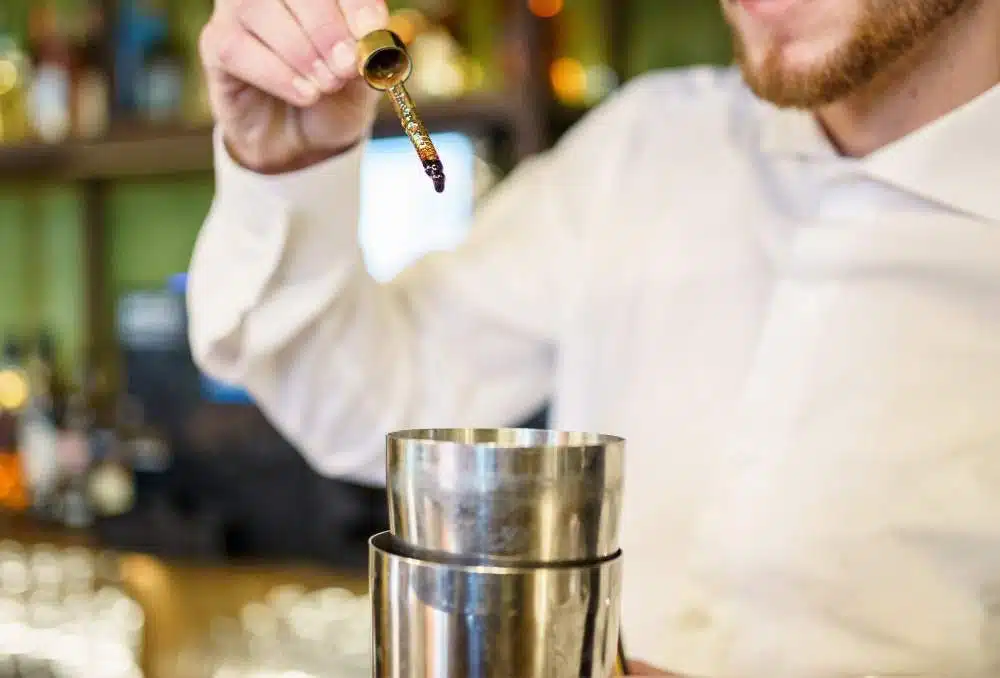
Bitters are the mixology and bartending equivalent of salt and pepper in cooking. They are the seasoning for your cocktails by balancing, enhancing, and tying flavors in a drink. Bitters are made from neutral alcohol infused with botanical ingredients like spices, herbs, fruits, flowers, roots, and bark.
These flavoring ingredients give each bitters brand its signature taste, color, and aroma. The recipes for making bitters vary widely, but common ingredients are cinchona bark or gentian root due to their distinct bitter note, zesty essences of lemon or orange peels, and warm, spicy ingredients like cinnamon, cloves, and anise.
A thorough maceration process helps to extract as much flavor as possible. The result is an intensely flavored, bitter-tasting, and complex extract with an alcohol content of 35% to 45% ABV (Alcohol By Volume), equaling 70 to 90 proof.
Bitters for cocktails are made of three main components:
A neutral, high-proof alcohol is key to extracting the flavors of the ingredients. In rare cases, bitter producers also use flavored spirits like aged rum or whiskey to create a distinct flavor profile. Alcohol-free bitters use vegetable glycerin as an alternative.
Cocktail bitters always contain a bitter base ingredient that helps to build complexity. In many cases, that's either gentian root or cinchona bark. Gentian root is the most common option due to its clean, bitter taste.
The plant grows in the European Alps and is used in bitters for cocktails, but also in bitter liqueurs like Amari. Cinchona bark, on the other hand, is best known for being the key ingredient in tonic water. Further bettering agents are wormwood, cassia bark, dandelion root, and Angelica root.
The flavorings are the main component in bitters. There's a variety of ingredients to flavor bitters, and most brands use a large set of ingredients to create more complex flavor profiles.
Aromatic bitters like Angostura often use a warm mix of spices like cinnamon, nutmeg, cloves, and allspice. Citrus bitters like Regan’s Orange Bitters use peels of citrus fruits to bring bright citrus flavors into their bitters. Herbal bitters include coriander, sage, and cardamom, while floral bitters rely on lavender, hibiscus, rose petals, and chamomile. Fruity bitters use whole fruits to flavor the alcoholic base with cherry, passion fruit, or pineapple.
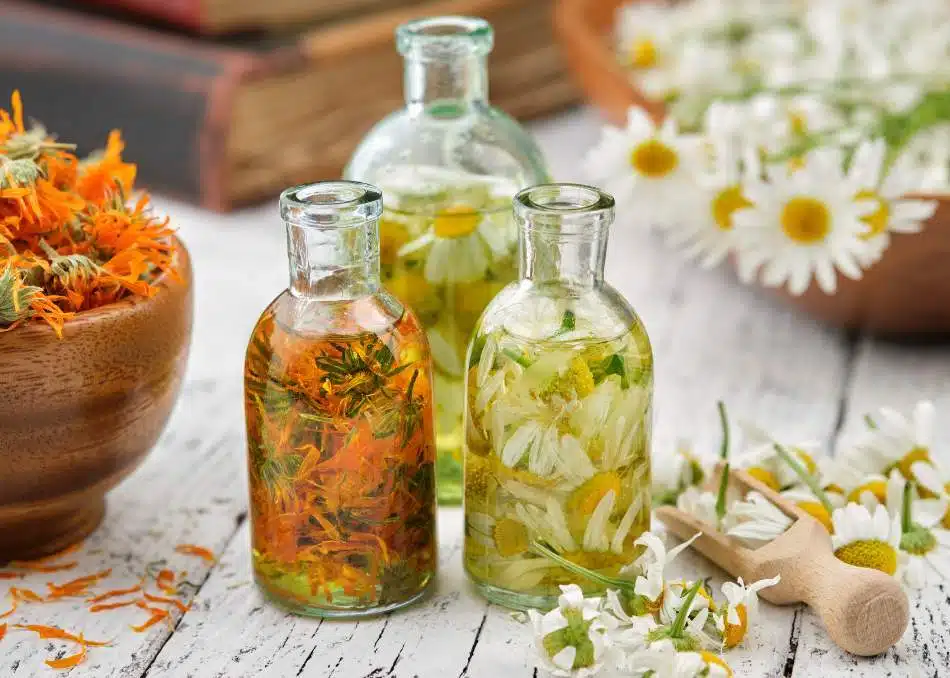
Making bitters is not rocket science. Usually, bitters are high-proof alcohol infused with botanicals. The alcohol extracts the flavors and aromas during the process. And the base spirit can be anything. If making your own bitters, vodka is a great choice. But you could also use whiskey or rum.
These are the steps to make bitters:
As the alcohol is high-proof, your bitters will almost live forever. So don't worry if the batch you created seems quite large. You'll have plenty of time to use them.
In case you want to make non-alcoholic bitters, the process requires fewer steps but a longer maceration process. A base of water and vegetable glycerin with a ratio of 25% to 75%. Add your botanical flavorings and shake the mixture every second day for the next 6 to 8 weeks; Then strain and bottle.
The exact taste varies for each product, but they all have a distinct bitter note. Angostura bitters, for example, pair bitter flavors with a mix of warm, spicy flavors of cinnamon and cloves. These warm, complex flavors help create more flavor depth in simple drink recipes like Old Fashioned or Manhattan.
Other, more specific bitters often bring a very distinct flavor into drinks. For example, lavender bitters add floral and perfumy lavender notes to cocktails, while chocolate bitters bring in a sweet and rich chocolate note.
Most bitters have a high alcohol content of 35% to 45%. ABV. That helps to preserve the intense flavors and even amplifies the taste. However, there are also non-alcoholic bitters that contain no alcohol at all. These are excellent for mocktails or if you want to flavor plain club soda.
Bitters are easy to use. Simply add a dash of bitters to your cocktail, to easily balance the drink's flavors while deepening the flavor profile. That effect is based on the idea that a dish or a drink tastes better if it covers as many of the five basic tastes as possible. These are sweet, sour, salty, bitter, and umami.
A primarily sweet and sour drink, benefits immensely from the bitter depth. A look at Sour cocktails illustrates this principle. A sour consists of spirit, citrus juice, and simple syrup, which makes it primarily sweet and sour. Adding two dashes of aromatic bitters increases the complexity of flavors and adds a distinct bitter note. To further improve the flavor profile, add a salty note by incorporating a few drops of saline solution.
This way of using bitters works best in simple concoctions with limited ingredients. Highballs are excellent for experimenting with cocktail bitters. A Rum & Coke enhanced with cherry bitters and a Vodka Soda flavored with orange bitters are easy to make and are much better drinks. You can also improve your classic Gin and Tonic with bitters by pairing flavors of bitters with botanicals in the gin.
But classic two-ingredient cocktails benefit from flavor complexity. For example, you can lift your ordinary Dry Martini by using bitters in the drink.
When using bitters to make cocktails, there are three different ways to incorporate them:
If bitters are regular ingredients, they're combined with base spirit, sweetener, and other ingredients like citrus juices and liqueurs. The drink is then stirred or shaken. This way of incorporating bitters makes full use of the complex flavor profile and deepens the flavor profile of a cocktail.
When using bitters as a garnish, the bitters don't mix as well with the other ingredients. Therefore, they only add a visual touch and an elevated aroma to the drink.

There are thousands of cocktail recipes that use bitters. Here are the most famous ones:
This list is by no means complete. You can write entire books about drinks using cocktail bitters. However, it gives you a quick introduction to how bitters work and what kind of drinks you can make with them. From there, you may experiment, discover, and explore further recipes.
Using bitters in soda water is one of the easiest and most refreshing ways to use cocktail bitters. You can either make a plain version, known as Bitters and Soda or "Bits and Bubs," or opt for the more flavorful combination called Rock Shandy, consisting of 1 part club soda, 1 part lemonade, plus half a teaspoon of Angostura bitters.
Both drinks are easy to make and super refreshing. The best of it: these beverages are tasty, almost alcohol-free, and good for your guts.
You can use bitters in many ways. By remembering that bitters are basically seasoning, you may use their aromatic flavors in beer, wine, tea, coffee, marinades, and food. There are no limits to how you can use bitters.
In most cases, bitters are used in small quantities, either in drops or dashes. This measurement may sound inaccurate, but one dash equals 0.92ml or 1/32 of an ounce. If you want to compare them directly: one dash is as much as ten drops. For a more detailed look at these measurements, check out our guide on "How much is a dash?"
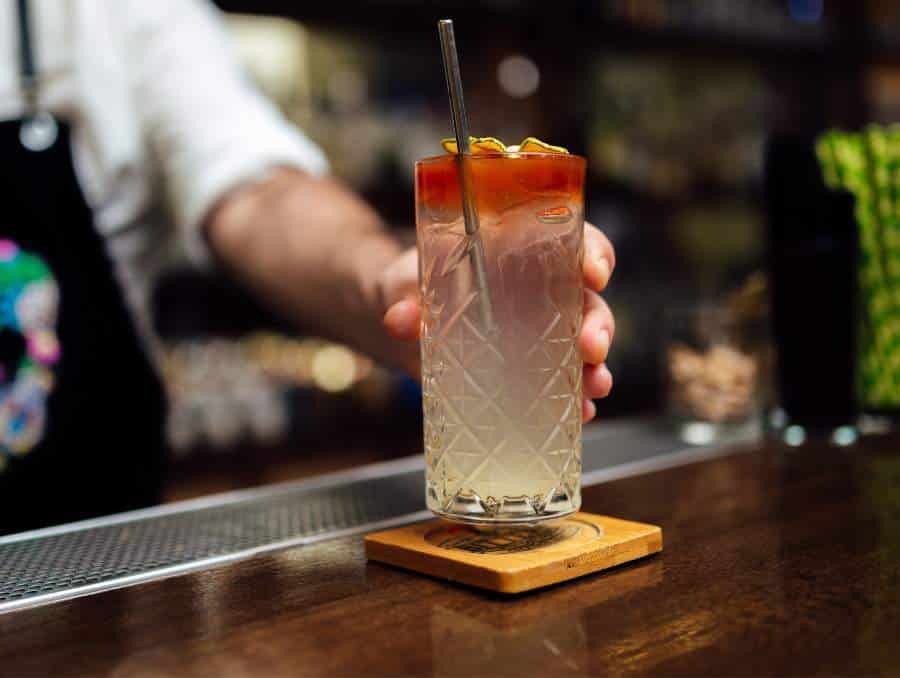
Many people asked us whether it is okay to use bitters as ingredients in non-alcoholic drinks and Mocktail recipes. The answer is, that using standard (alcoholic) bitters will always bring alcohol to your drinks. So, if you aim for no alcohol, don't use alcoholic bitters.
However, looking at the legal point of view, in the United States, every beverage below 0.5% Alcohol By Volume counts as non-alcoholic.
With this standard, drinks like Bitters & Soda or Rock Shandy certainly are alcohol-free. If you're looking for beverages that contain strictly no alcohol, opt for non-alcoholic bitters instead.
Yes, there are non-alcoholic bitters available for cocktails. Most of these bitters are glycerin-based bitters, like alcohol-free ones from All The Bitter or El Guapo. They use a blend of botanicals to provide rich and complex flavors to drinks without the alcohol content. They might not pack the same amount of flavors as standard options, but these non-alcoholic bitters are perfect for anyone who wants to enjoy flavorful drinks without any alcohol.
Yes, they absolutely can get you drunk. The standard ABV of bitters ranges between 35% and 45%. Angostura bitters, the most popular ones, contain a whopping 44.7%, making it stronger than standard gin, rum, and whiskey, which typically clock in at 40% ABV.
However, adding a few drops or dashes to your soda water won't do so. Instead, you must drink bitters pure (not recommended) or use them as a base in cocktails like a Trinidad Sour. Then, bitters, like any other strongly alcoholic spirit, will get you drunk.
Bitters have a fascinating history that spans centuries, evolving from medicinal tonics to essential cocktail ingredients. Their origins trace back to ancient Egypt when herbs were infused into wine for their therapeutic properties.
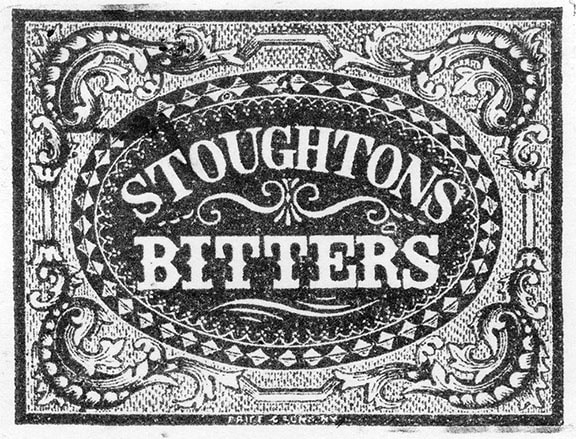
During the Middle Ages, the availability of distilled alcohol led to the development of herbal medicines, and concentrated herbal bitters and tonic waters became common.
In the 16th century, physician Paracelsus compounded bitters for medicinal purposes, laying the foundation for their use in treating various ailments. By the 18th century, adding herbal bitters to wine had gained popularity in Britain and the American colonies. As a forerunner of the Old Fashioned, Stoughton's bitters were added to sweetened brandy to create a balanced, flavorful drink that was supposed to be good for your health.
In 1806, the cocktail was born, a mixture of spirits, sugar, water, and bitters. Bitters played a crucial role in softening the taste of harsh liquors in cocktails.
Angostura bitters, named after a city rather than the angostura tree, became famous in the early 19th century for their medicinal properties.
Thanks to innovative bartenders, a revival of cocktails and mocktails in the 1990s renewed interest in bitters. Today, bitters come in various flavors and types, and mixologists continue to experiment with new combinations, making them an indispensable part of modern cocktails and a testament to their enduring legacy in the world of beverages.
Bitters were traditionally produced as medicinal tonics to help with a healthy lifestyle. And in fact, bitters can indeed have some health benefits. The taste of bitterness triggers our bodies, which respond by increasing the production of digestive juices and saliva.
This natural reaction aids in the breakdown of food, leading to better nutrient absorption and supporting liver detoxification. Moreover, there's a fascinating link between our taste buds and stress reduction through the gut-brain connection, suggesting that consuming bitter foods might help alleviate stress.
Additionally, activating specific receptors in the mouth and gastrointestinal tract by bitter compounds can contribute to weight control and reducing sugar cravings. While moderation is key, incorporating bitter flavors into your diet can offer these health advantages and contribute to overall well-being.
Digestive bitters and cocktail bitters, although sharing a similar extraction process from bitter roots and herbs, serve distinct purposes. Digestive bitters are primarily designed for potential digestive benefits and are often categorized as herbal supplements. They are generally less favored and focus on the bitterness of the herbs.
In contrast, cocktail bitters are crafted with a heavier emphasis on flavor and seasonings, intended to enhance the taste of cocktails. While there is ingredient overlap between the two, digestive bitters prioritize their potential health benefits, whereas cocktail bitters are dedicated to elevating the taste profiles of mixed drinks.
Popular digestive bitters are amaro liqueurs like Campari and Fernet Branca, and other herbal liqueurs like Jägermeister, Underberg, Unicum, and Riga Black Balsam.
For cocktail bitters, there are many brands we love and recommend, like The Bitter Truth, Bittermens, Scrappy's, Fee Brother's, and more.
When you only had the choice between Angostura and Peychaud bitters, there was no need for categories. Today, that changed dramatically.
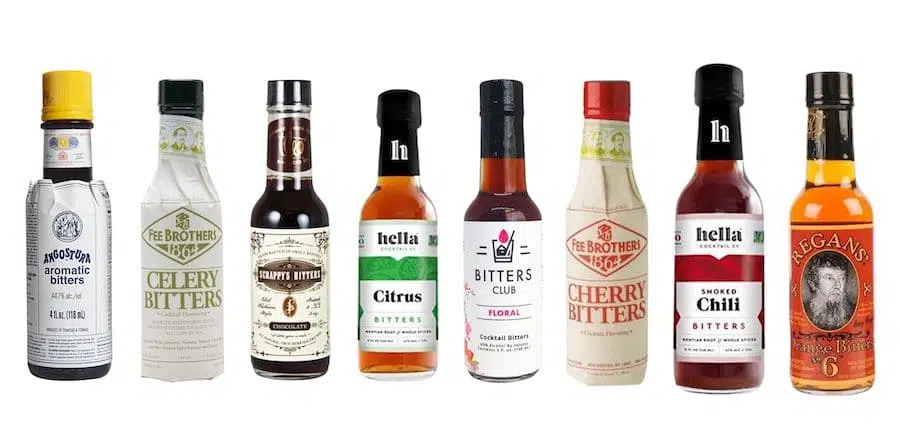
A wide range of flavors is available, and to keep track, we need to categorize them. Yet, some flavor profiles are so unique that you can't classify them. However, most fall into one of the categories below.
Aromatic bitters like Angostura are traditionally made of botanicals like cinnamon, clove, ginger, cardamom, and more. They often are used in classic Rum and Whiskey cocktails, like an Old Fashioned. But they also work well on top of egg-white foam of sour cocktails like Whiskey Sour.
Peychaud's Bitters were invented by Antoine Peychaud, a Creole apothecary originally from Saint-Domingue, now known as Haiti. After settling in New Orleans in the late 18th century, Peychaud crafted these gentian-based bitters with a unique profile. Peychaud's Bitters are characterized by their pronounced anise aroma complemented by subtle mint undertones, setting it apart from other bitters like Angostura.
Celery-flavored bitters have been around since the 19th century but with slightly different recipes. The modern take on celery bitters usually is based on celery seeds. While it may sound like a weird idea, their vegetal and earthy notes work exceptionally well when combined with citrus notes from a lemon. I prefer them in Martinis and selected Gin cocktails.
Chocolate bitters are made with cocoa and cacao. They work great with barrel-aged spirits, and I love to combine chocolate bitters with Rum or Rye Whiskey Old Fashioneds. The chocolatey notes also work great with vanilla and coffee aromas that, in turn, all work great with a good, aged Rum.
Citrus bitters usually are obtained from lime, lemon, and grapefruit. You can also find some that combine two or even all three citrus fruits in a single bitters bottle. The result is a very bright and complex citrus aroma.
If you don't know what to expect from floral bitters, think of chamomile, lavender, hibiscus, and jasmine. This group might be the most versatile category. Depending on the botanicals used, floral bitters can taste very different. They usually work great in Gin drinks and are often paired with a floral cocktail garnish.
You can make fruit cocktail bitters from all sorts of fruits. Because orange and other citrus fruits have their category, they are excluded here. The fruit bitters category is for all remaining fruits. Try, for instance, apple and cranberry in the winter or peaches in the summer.
I love the idea of hot and spicy bitters very much. They allow you to add a very well-balanced level of spiciness to your drink without overdoing it. If you try the same by using jalapeño or habanero chilies in your cocktail recipe, it can become quite tricky to balance the spice.
You probably wonder why we have citrus and orange bitters on this list. While oranges are citrus fruits, there are just so many different orange bitters that they have a separate category. These bitters work great in a Dry Martini but also in other classics like a Negroni.
If you don't know which cocktail bitters to choose for your home bar, I have these recommendations for you - of course, the classics ca not be missed:
Collins cocktails have a long history that dates back to the 1800s. It's a sour-style drink, originally made with gin as the base spirit. The Scotch or Sandy Collins is one of many riffs on the classic John Collins recipe.
Quick Facts Scotch Collins
Scotch Whisky is known for its peated smoke flavor. Yet, for this drink, you'll want to use a Scotch with a restrained smoky taste.
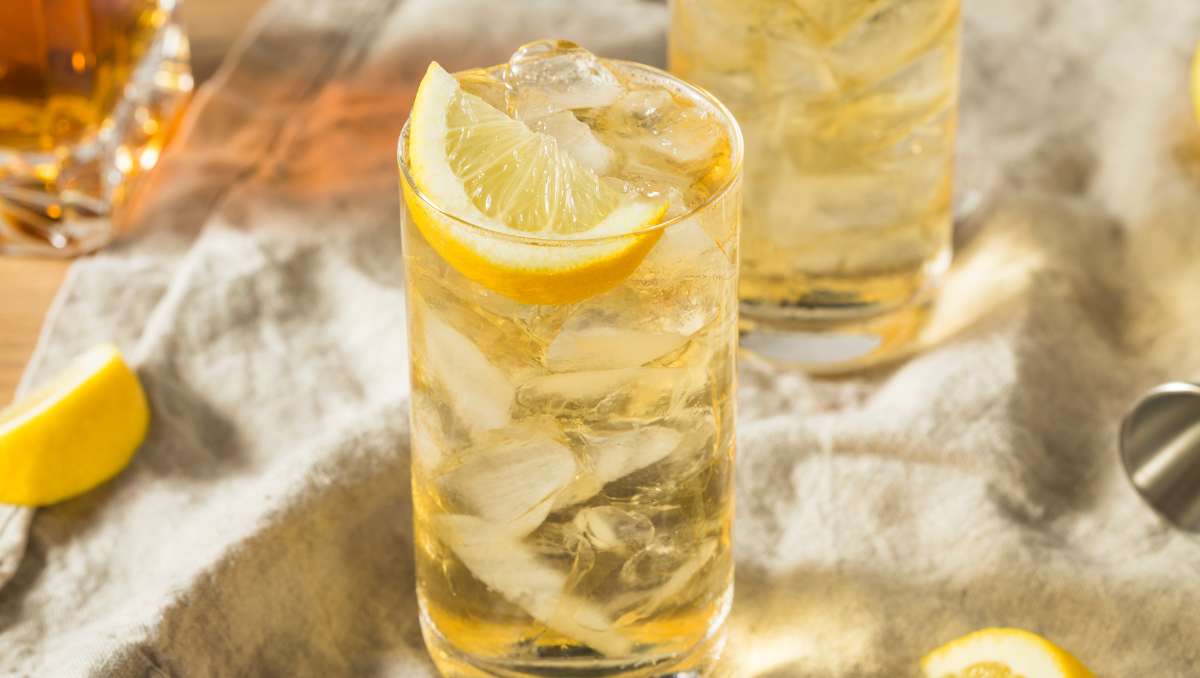
Collins cocktails are known for being super refreshing. The reason is the combination of fresh lemon juice and chilled soda water. These two ingredients bring in citric acidity as well as some bubbles.
But there are more ingredients that make or break a great Scotch or Sandy Collins. Here's what you need:
Peychaud's bitters and Angostura bitters are the most popular aromatic cocktail bitters. In most classic cocktails, Angostura bitters are used to add aromatic flavors and depth to a drink. But not in the Scotch Collins.
Now, while a Whiskey Collins based on Bourbon usually requires Angostura bitters, a Scotch Collins is better flavored with Peychaud's bitters.
Scotch and Peychaud's are just a much better fit than Scotch and Angostura bitters. Give it a try, and you will know what we talk about.
To make a Scotch Collins, you shake part of the ingredients first. Then strain the contents from your shaker into your Collins glass and top it up with the bubbly soda.
Take a Collins glass and fill it up with large, clear ice cubes. If you have a so-called Collins stick - a long, rectangular ice block that fits the glass- that's even better.
Since you don't shake the soda water with ice, it should best come straight out of the fridge to ensure your cocktail is ice cold when it reaches the table.
Also, stir very gently once you have added the soda into the glass for it to maintain its fizz.
As mentioned, the Scotch Collins Collins is a member of an entire family of drinks. Besides the original - the John Collins- there are, for instance:
If you prefer to mix up some more Scotch drinks, how about these:
The Scotch Sour is one of many Whiskey Sour variations and definitely a rarer choice. -Oddly enough, because the flavors in a Scotch Sour are beautiful and perfectly balanced.
Some recipes omit the sweetener in this recipe. However, we don't recommend that. Making a Scotch Sour without syrup will potentially be quite overwhelming - especially, if you expect a typical Sour Drink.
Quick Facts Scotch Sour Cocktail

To make this subtly smoky and well-balanced drink, you need Scotch, fresh lemon juice, Peychaud's bitters, and simple syrup. Adding an egg white for a frothy top and a better mouthfeel is optional. Here are some more details on what we like to use for our Scotch Sour recipe:
David Embury, a legendary mixologist and cocktail book author, found that Peychaud's bitters do a fantastic job in drinks made with Scotch. -Even better than Angostura bitters would.
If you're interested in the details regarding the differences, read our article about Peychaud's vs. Angostura bitters.
Generally, a Scotch Sour doesn't need an egg white. However, as in many other Whiskey Sour drinks - like the New York Sour or Continental Sour - I find the mouthfeel very pleasant. The silky texture of the egg white poses a beautiful contrast to the peaty flavors of the Scotch.
I use half an oz or one oz to get that beautiful frothy top. If you don't feel like adding raw egg white to your cocktail, you can use aquafaba instead.
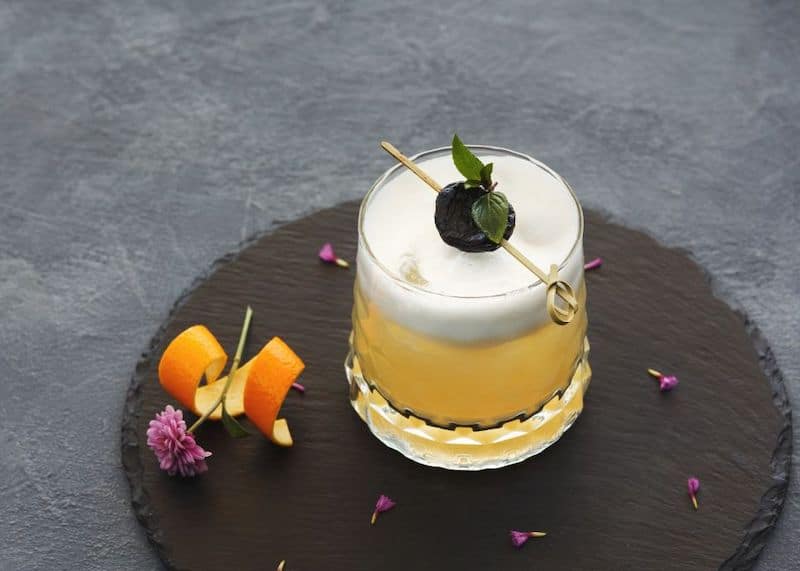
We like our Scotch Sour best with some egg white for a frothy top and a better mouthfeel. In order to achieve a perfect foamy egg white top on your drink, you have to dry-shake the cocktail.
First, add Scotch, lemon juice, egg white, syrup, and Peychaud's bitters into a cocktail shaker without ice. Vigorously shake the mix for approximately 10 seconds to build up a beautiful foam.
Then, open the shaker and add ice. Close it and shake again for 5 to 8 seconds. Now, your drink is well-chilled, and the shaker should feel frosty on the outside.
Finally, strain the drink into a Rocks glass over one large, clear chunk of ice. Don't use the small, hollow cubes. These will water down this beautiful drink way too quickly.
One variation of this drink is to omit the syrup. If you plan to make a Scotch Sour with only lemon and whisky, we recommend using aged lemon juice: squeeze the juice a couple of hours before mixing and let it sit for a while. That takes away the harsh, acidic bite.
You can read more about the reasons behind this in our guide on lemon juice.
Should you be a fan of intensely smoky Scotch Whisky and want to bring that into your drink, opt for a Laphroaig 10 years or even a Lagavulin 16 years instead of a blended Scotch.
The only difference between a Whiskey Sour and a Scotch Sour is the type of spirit that's used for making the cocktail. A regular Wishkey Sour usually includes Bourbon or Rye and a Scotch Sour - yes, right - Scotch.
The obvious distinction between these whiskey types is the fact that Scotch is always from Scotland. The area of production has a great influence on the final taste of a product.
The characteristic peat-dried malt used to make the Scottish spirit is responsible for its iconic smoky taste that also is pronounced in the recipe. - However, how much of a difference there is to the standard version depends on the type of Scotch you opt for.
The Scotch Sour falls in line with a long list of Sour Cocktails - and we frankly love all of them. Apart from the various options with whiskey, you can also get creative and try one of these:
For more inspiration, check out this overview of our favorite Sour Cocktails.
The Rob Roy cocktail, sometimes also called a Scotch Manhattan, follows the same formula as the famous drink from New York. There's one small yet effective difference, though: the recipe replaces Bourbon or Rye with Scotch Whisky.
The drink is one of the few classic cocktails made with Scotch. And let me tell you, the Rob Roy is a beautiful way to imbibe a fine Scotch Whisky.
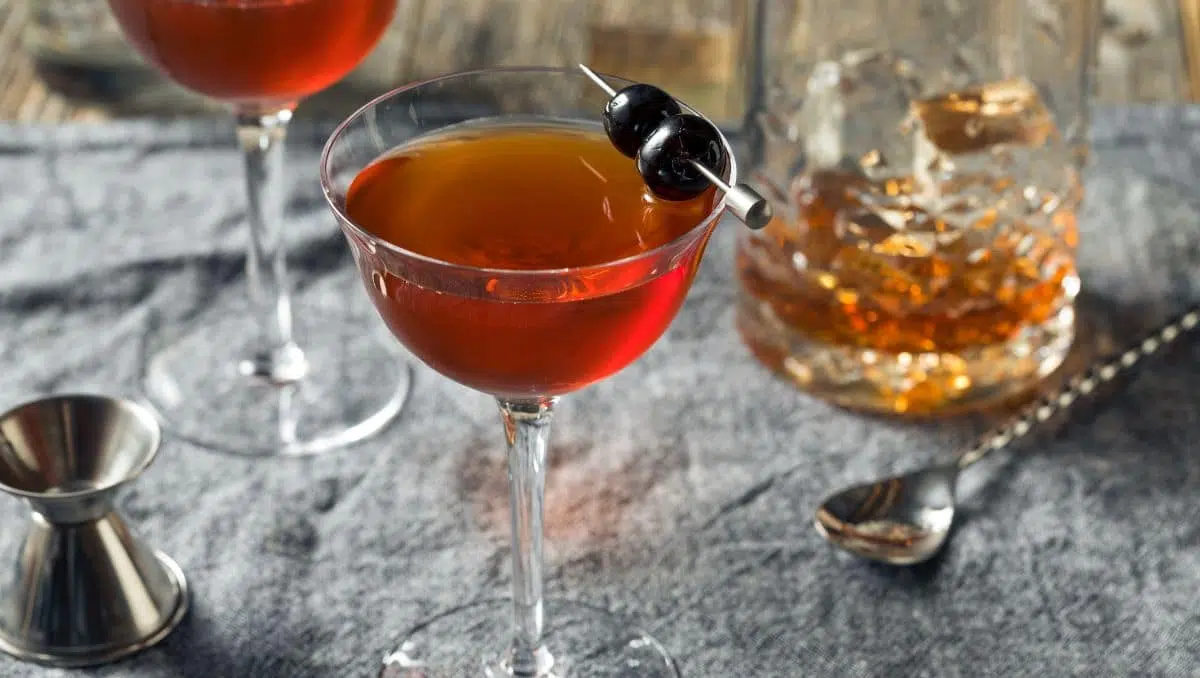
The list of ingredients for the Rob Roy recipe is almost identical to the Manhattan but made with Scotch instead of Rye or Bourbon. So to make this classy booze-forward drink, you'll need:
It looks pretty easy and straightforward it is. Still, selecting the whisky is key and can be tricky.
Blended Scotch is the best choice for this whiskey cocktail because it usually is not overly peaty and affordable. Also, don't go for a whisky from the Islay region, known to produce intensely smoky spirits.
In a Rob Roy, this smoky taste won't work too well. It can quickly overpower the delicate flavors of the sweet vermouth. Hence, you want something that's smooth and leaves room for the herbs and spices to shine through.
Blended Scotch is made by combining aged malt whisky with aged grain whisky. The taste is typically smooth and well-rounded - just want we want.
Another common choice is Single Malt Scotch. They are produced in one distillery and are usually a bit more expensive. If you have a preferred bottle when it comes to Single Malts, give it a try in a Rob Roy. Although, also here, I don't recommend Islay Scotch for the same reason described above.
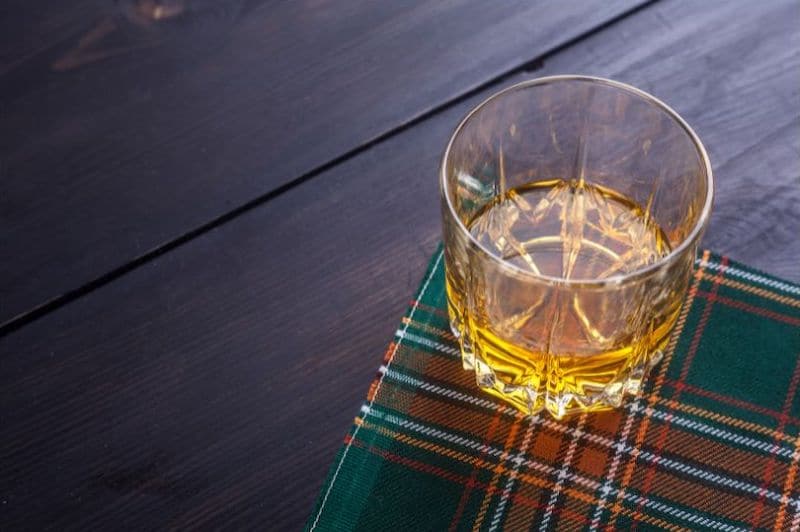
Traditionally a Rob Roy is made with Angostura bitters. But David Embury, attorney, and famed mixologist, mentioned in his book The Fine Art of Mixing Drinks that Peychaud's bitters are actually a better choice. He wrote:
"Peychaud, somehow, seems to blend better than Angostura with Scotch."
Today, both versions are common. I prefer a combination of both: one dash of Angostura bitters and one of Peychaud's bitters. If you want to use only one, double the amount accordingly.
Either way, in the end, the most important thing is that you use bitters and don't omit them. They're essential to achieve the right balance and complexity in this drink.
If you're unsure about the differences, read our article about Angostura bitters vs. Peychaud's bitters.
The traditional way to garnish a Rob Roy is with a Maraschino cherry. These luscious and dark red cherries are full of flavor, sweet, and a little almondy.
Genuine Maraschino cherries are expensive. So, if you can't or don't want to get them, make them at home with our recipe for homemade Maraschino cherries. Alternatively, consider using Amarena cherries. They have a similar sweet but natural flavor, are of high quality, and are more affordable.
As mentioned above, don't go for the fake Maraschino cherries - they don't add anything to the drink other than an unpleasant candy flavor.
Supposedly, the Rob Roy first came up in the 1890s, around ten years after the invention of the Manhattan cocktail.
A bartender at the renowned Waldorf Astoria Hotel in New York City is said to have thought up this variant of the Manhattan. -In 1894, to be precise.
He named his creation after an Operetta written by Reginald de Koven, which, in turn, goes back to a Scottish folk hero called Rob Roy. However, similar concoctions must have existed before. Only there hadn't been a name for them.
A bar guide from the 1880s published by Charlie Paul included one of the first-ever written Manhattan recipes. In this recipe, the drink is not made with Rye but Scotch.
That was probably not done purposefully, but due to the fact that it was a London bar guide and Scotch was readily available in England.
The Rob Roy is in line with many vintage whisky drinks from the early era of cocktails and mixology. Apart from the Manhattan, here are some more worth trying:
The template for sour cocktails is always following the same principle, and the Pink Gin Sour also plays by those rules. A spirit base is mixed with citrus juice and balanced with a sweetener, but adds a little extra and asks for a particular brand of Gin as well.
Carson Quinn, brand ambassador of Iron Balls Gin, thought up the colorful twist. So, it's no surprise that Iron Balls makes the base of this Pink Gin Sour.
You need Gin, syrup, and lemon for this drink, plus extra egg white and some bitters to create the iconic look of this delightful cocktail:

Iron Balls Gin is a beautifully crafted Gin from Bangkok. The small-batch distillery is located inside the Iron Balls distillery & bar. It's perfect for this Pink Gin Sour but also works beautifully in a Gin and Tonic with Fevertree Mediterranean garnished with fresh pineapple and basil.
Peychaud's are aromatic bitters, just like Angostura's. The latter is more popular, and also part of this recipe. If you want to know more about those two brands, check out this comparison of Peychaud's vs. Angostura bitters.
In case you're still not convinced but want that froth, try aquafaba instead. The chickpea liquid is vegan and creates a nice foam, as well. You can read how the two compare in our comparison of Aquafaba and eggwhite.

The preparation of this drink is similar to other sour cocktails. However, incorporating egg white requires an extra step: dry shake or reverse dry shake to get the perfect foam.
For a dry shake, put all ingredients into your cocktail shaker without ice and start shaking for 15 seconds. This step gives the egg white its beautiful frothy texture.
In a second step, open the cocktail shaker and add ice. Then shake the drink again to chill it.
Strain the Pink Gin Sour into a Coupe or Martini glass and garnish it with Angostura bitters and candied orange or a slice of dried orange.
As the recipe particularly asks for fruity Iron Balls Gin, it's pretty hard to find an equivalent substitute. Thus, our recommendation would be to opt for another Asia-inspired Gin.
For instance, Bobby's Gin brings in beautiful notes of lemongrass and cinnamon. Alternatively, you can also try Roku Gin. This one brings in a Japanese touch of cherry blossoms and yuzu fruit.
These two would create a slightly different drink but are great options if you can't get your hands on Iron Balls.

The famous French Quarter of New Orleans is home to many influential cocktails in the history of mixology. One of them is the Vieux Carré Cocktail. The refined recipe is full of flavor and contains cognac, whiskey, sweet vermouth, D.O.M. Bénédictine, and bitters.
Quick Facts Vieux Carre Cocktail
The Vieux Carré is a short drink and comparable to the Manhattan cocktail. However, the Vieux Carré is a lot more complex.

For a short drink, the Vieux Carré has a relatively long list of ingredients, making this one of the most sophisticated and ambitious of the vintage cocktail classics:
For an authentic Vieux Carré Cocktail, you do need D.O.M. Benedictine. However, you can replace it with other herbal liqueurs if you don't want to get a bottle.
With only a bar spoon, the question of whether it really makes a difference and if you really have to buy a bottle of this liqueur is understandable and justified. Yet, it does make a difference:
D.O.M. Benedictine is a liqueur made with herbs, spices, citrus, and saffron from Normandy in France. The flavor is extremely complex, and intense. So as little as one bar spoon will alter the overall taste of your drink.
However, if you want to replace it, Green Chartreuse, Drambuie, and even Jägermeister are among the common substitutes.
The Vieux Carré is intense, boozy, and bold. It's sweet, bitter, smooth, and very alcoholic. The drink's base is a blend of Rye and cognac, both of which are able to unfold their aroma. The spicy notes from the whiskey blend amazingly well with the smooth, fruity, floral notes of the premium brandy.
The rich sweet vermouth combined with the herbaceous notes from D.O.M. Bénédictine brings a broad mix of herbs, spices, and botanicals. To round everything off, two different cocktail bitters add depth of flavor.
If you're familiar with both Manhattan and Sazerac, you can look at the Vieux Carré Cocktail as a mix of these two.

Vieux Carré literally translates to Old Quarter. Vieux means old in French, and Carré quarter or square. It refers to a common nickname for the French Quarter in New Orleans: Old Quarter.
The French Quarter in New Orleans is probably the most famous part of the town. And as the name very much implies, it was under strong French influence. And the cocktail pays a well-deserved tribute to it.
It was back in 1938 in the legendary Carousel Bar where Walter Bergeron mixed up the very first version of the Vieux Carré. Located inside Hotel Monteleone, the Carousel Bar was one of the most popular spots in the French Quarter at that time.
Maybe you noticed that, despite the hotel being in the French Quarter, its name is Italian. This mix of heritages also reflects in the cocktail recipe:
The components of the Vieux Carre are French cognac, French brandy, American Rye whiskey, and sweet Italian vermouth. -A truly brilliant representation of the diverse American society in the early 20th century.
And its simple yet refined classiness is a principal reason why this cocktail is still on many cocktail menus all over the country.
New Orleans is home to many famous cocktails. And the Vieux Carré is certainly one of the more popular ones, but there is more:
Here are some more classic cocktail recipes you should try if you're a fan of the Vieux Carré Cocktail.
Drinks from New Orleans
Many different classic cocktail recipes originated in New Orleans. The most famous creations are
More Cognac Cocktails
If you like the Vieux Carré and want to try more cocktails based on Cognac, how about:
For even more cognac drinks, head over to the overview of our favorite brandy cocktails.
The city of New Orleans is famous for various recipes beyond the Sazerac. Classic cocktail recipes like the Ramos Gin Fizz, Vieux Carré, and the Brandy Crusta all originated in New Orleans.
However, the most famous of them still is the Sazerac cocktail. It is not only popular among bar patrons, but it also has an interesting history; -or actually, two histories.
As with many cocktails, the origin is somewhat unclear. However, in the case of the Sazerac, a variant of the story is largely invented. Learn more about New Orleans's official cocktail and how it really came to life.
The preparation of this drink has its own name: the "Sazerac" style. That usually describes how the glass is rinsed with Absinthe before pouring the cocktail. But let's have a look at this step-by-step.
Step 1: Fill a rocks glass with ice cubes and set it aside.
Step 2: Add sugar cube to mixing glass and muddle with bitters and half a teaspoon of water.
Step 3: Add ice cubes together with Sazerac Rye and stir the drink until well chilled.
Step 4: Discard the ice cubes from the rocks glass and pour in the Absinthe. Rinse the glass with it. Discard any excess Absinthe.
Step 5: Strain the drink into the rinsed glass and garnish with a lemon twist.

Over the years, the Sazerac cocktail has seen a few changes to the original recipe. So it is not surprising that today there are countless variations and riffs of the classic recipe.
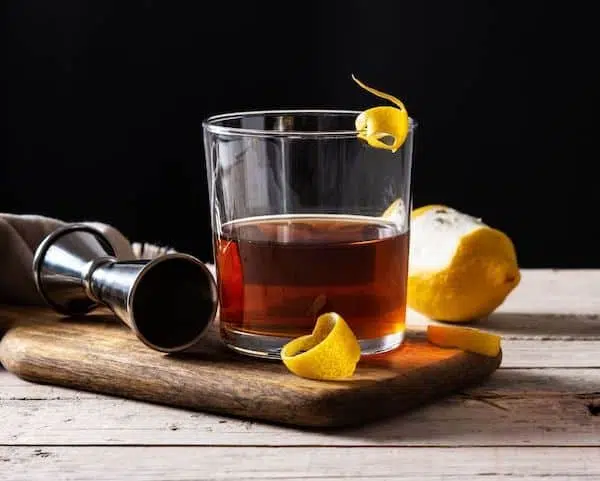
There are many drinks with an unclear history. With the Sazerac, for a long time, historians thought the story was straightforward: A man named Stanley Clisby Arthur made the world believe that Antoine Amedée Peychaud, inventor of Peychaud bitters, also invented the Sazerac.
He embellished the story, mentioned the secret bitters recipe that Antoine Peychaud's family brought from Haiti, and claimed that Antoine had invented not just any cocktail but the world's first.
He created a complete lore with countless details and additional information. For example, the cocktail is said to have found a home in John B. Schiller's bar, the Sazerac Coffee House.
For decades, many believed the story to be true. In recent years, however, cocktail historians could prove that Stanley Clisby Arthur was merely trying to establish Peychaud's bitters as the original recipe of all bitters (which they aren't) while spinning a tale of why and how they came to be part of the Sazerac. [1]
If you leave aside the invented history and solely rely on proven facts, the drink's history looks completely different.
The first thing that stands out is that the Sazerac cocktail was not at the beginning of Sazerac Coffee House's fame. There are many mentions of the coffee house between 1871 and 1885 without a single word about the Sazerac cocktail. [2]
In 1895, Vincent B. Miret and Billy Wilkinson (business partners and head bartenders at Sazerac House) filed a trademark application for their bottled cocktails. The first time the actual Sazerac cocktail appears in writing is in an Alpha Tau Omega Palm report from March 1899.
As a funny side note, the Absinthe rinse, an integral and iconic part of the Sazerac recipe, wasn't that special at this time. Actually, the Absinthe-rines Sazerac was almost the same as the ubiquitous Absinthe dashed "Improved Whiskey Cocktail". [3] Even the addition of Thomas Handy's bitters, giving the drink a rosy hue, didn't help to distinguish the Sazerac from that drink.
So, back in the day, the recipe of the cocktail wasn't new and innovative but what stood out was the fact that Miret and Wilkinson put on a spectacular old-fashioned bartending show, the likes of which you could only experience at Sazerac Coffee House in New Orleans.
Sadly, both inventors of the Sazerac died shortly after, which is one of the reasons why the origin of the Sazerac is not known. Miret died back in 1899, and Wilkinson shortly after in 1904. [4] [5]
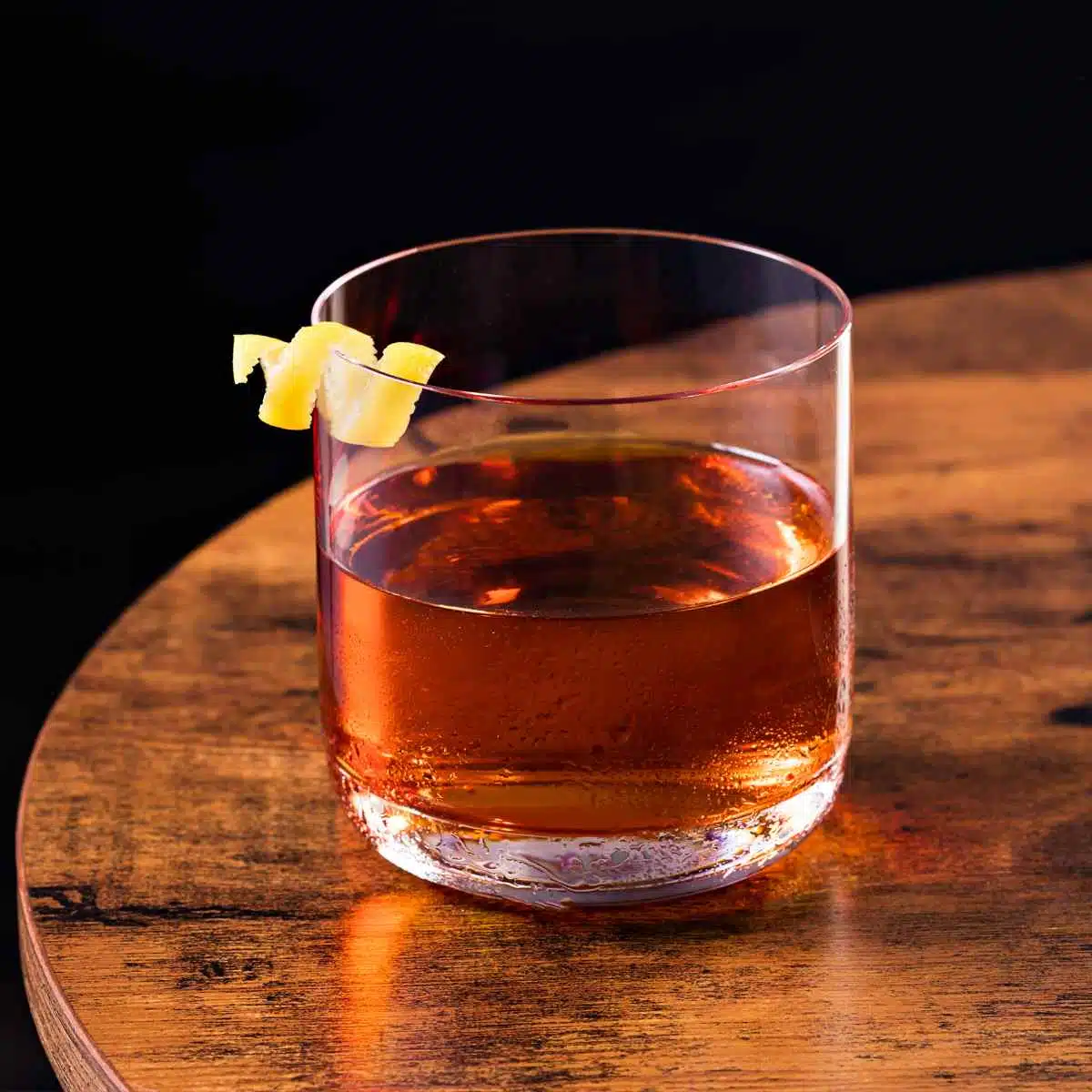
Rye is known for its spicy flavor profile, distinguishing the spirit from other Whiskeys like Bourbon, Scotch, or Irish Whiskey. Here are some popular cocktails you can make with Rye, except Rye Whiskey:
Peychaud's vs. Angostura is a comparison of two giants in the world of cocktail bitters. The beauty of these super-efficient elixirs is that just a few drops are enough to alter and enhance the flavor of your drink.
You can create whole new layers of flavor just by using a dash of bitters. That is also the reason why bitters are essential ingredients for making cocktails in today's cocktail culture.
And two of the most popular brands have been dominating the market for ages: Peychaud's and Angostura Bitters.
Both brands emerged in the 1800s and played a vital role in the history of cocktails and mixology. But what are the differences, and in what cocktails should you use them?
Time to take a closer look at the battle of the bitters: Angostura vs. Peychaud's
The origin of Peychaud's bitters is said to be Haiti. To be more precise, Antoine Amédée Peychaud brought the recipe from San Domingo, Haiti, to New Orleans.
But it was not him that made the recipe famous. It only got popular when his son, named, too, Antoine, started making it in his apothecary in the 1830s.
It took some years until it turned into a popular cocktail ingredient: In 1857, it first was advertised as a component of the Sazerac cocktail.

Angostura bitters are even a few years older. Dr. Johann Siegert invented them in 1824 as a medical tincture when he worked as surgeon general for Venezuelan military leader Simon Bolivar.
Just like Peychaud's, Angostura bitters is a family business. When the sons of Dr. Siegert joined the company, they created the iconic look of the Angostura bitters bottle.
Follow this link to read more on the history of Angostura bitters.
Besides their age and standing in the cocktail and bar industry, the two products are notably different. And both have very distinct flavor profiles.
Peychaud's bitters are less bitter with more pronounced sweet notes and a strong anise taste.
Angostura bitters, on the other hand, are full of spices like cassia, cloves, and cinnamon. That makes for a deeper flavor profile and a more savory taste.
Another difference between the two brands is the amount of alcohol. While Angostura contains around 44.7% ABV, Peychaud's bitters have a significantly lower amount of alcohol (35% ABV).
Both products are common ingredients in cocktails. Angostura is the most used bitters brand by far. Nevertheless, many classic cocktail recipes ask for Peychaud's bitters. .
Angostura produces the ultimate allrounder. Whenever a classic cocktail recipe asks for bitters, you can use their aromatic bitters without a second thought.
They are key to most of our favorite Sour Cocktails like the Pisco Sour or more exotic riffs like the Shochu Sour or the Pink Gin Sour.

Then there are classics like the Martinez, the Horse's Neck, or the Dark'n'Stromy, and also twists on classics like the Samurai Old Fashioned calling for a few drops of the flavor bomb from Angostura.
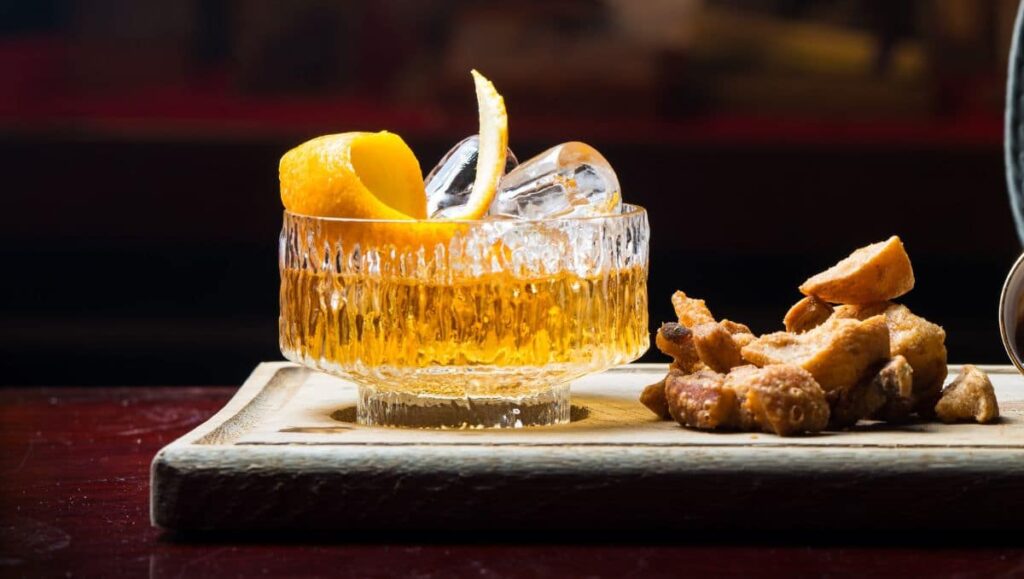
The most popular drink with Peychaud's is probably the already mentioned Sazerac. But it is also a key ingredient in recipes like Vieux Carré or the Queens Park Swizzle.
So even though they are not a perfect replacement for Angostura bitters, there are cases when Peychaud's bitters are the better option.
Their bitters are light and dry with strong notes of anise. It balances sweetness and acidity pretty well, making it a fantastic choice for drinks with many sweet or sour ingredients.
But to be honest, there is a reason why Angostura bitters are more popular. And it is not because one is ultimately "better" than the other.
Like I said previously, Angostura works with almost every flavor combination. They add complexity, and usually, you don't have to worry if it works. Just put some Angostura bitters to your cocktail, and they improve your drink nicely.
With Peychaud's bitters, you have to be more careful. They don't work all the time, and there is more trial and error involved in finding the perfect amount of Peychaud's bitters.
The most popular cocktail bitters are very dissimilar in taste. And they're also used in very different recipes.
Saying this, it makes sense to have them both at home. And it also makes sense to get familiar with what they actually do with your drinks.
Ultimately, Angostura bitters and Peychaud's bitters can lift your cocktails to the next level.